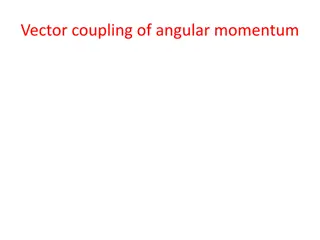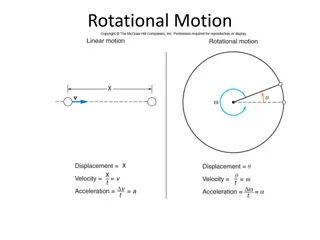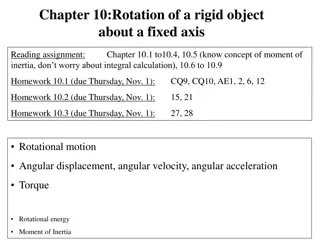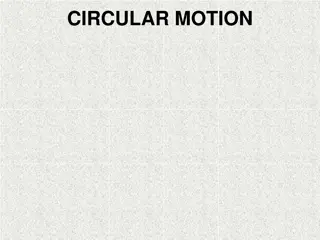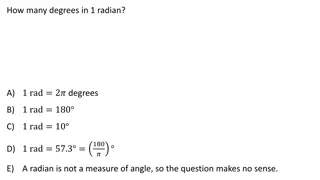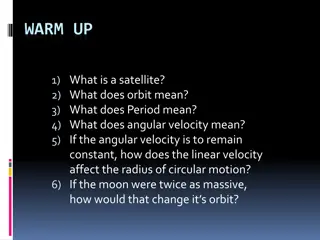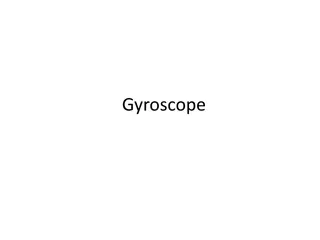Angular Momentum in Mechanics
Explore the key concepts of angular momentum in mechanics, including the difference between linear and angular quantities, angular momentum calculations, conservation principles, and practical examples illustrated on whiteboards. Delve into formulas, equations, and scenarios to grasp the fundamental
5 views • 27 slides
Angular Mechanics - Angular Momentum Concepts and Examples
Understanding angular momentum in mechanics involves reviewing linear and angular quantities, comparing angular to linear formulas, and exploring examples of angular momentum and conservation principles. The content covers key factors like angular quantities, torque, and moment of inertia, along wit
3 views • 23 slides
Projectile Motion: Characteristics, Examples, and Formulas
Projectile motion involves the motion of objects under the influence of gravity, with both vertical and horizontal components. This type of motion is seen in activities such as throwing a ball, kicking a football, or dropping objects. The motion is described by specific formulas, including calculati
2 views • 19 slides
Rotational Motion: Angular Velocity and Acceleration
Explore the concepts of angular velocity, radians, and rotational motion in this educational content. Learn about the relationship between angular and linear velocity, angular acceleration, tangential acceleration, and centripetal acceleration through practical examples. Enhance your understanding o
4 views • 17 slides
Motion: Frames of Reference and Relative Motion
Motion is defined as a change in position over time. To describe motion accurately, one needs to understand frames of reference and relative motion. Frames of reference are systems of objects used to determine if something is in motion, while relative motion involves movement in relation to a refere
3 views • 14 slides
Angular Momentum in Quantum Mechanics
Exploring the concept of total angular momentum in quantum mechanics, which involves the quantization of orbital and spin angular momenta. The coupling of these vectors leads to the formation of total angular momentum, with implications for the behavior of single-electron systems like the hydrogen a
0 views • 16 slides
Motion: Concepts and Definitions in Physics
Motion in physics is defined as the change in position of an object over time. It involves concepts like rest, motion, distance, displacement, rate of motion, and types of motion. Rest and motion are relative to a reference point, while distance and displacement differ in their scalar and vector nat
2 views • 25 slides
Angular Overlap Method in Advanced Inorganic Chemistry
Exploring the Angular Overlap Method (AOM) in advanced inorganic chemistry provides a qualitative discussion on the physical rationale behind the theory of complexes. By considering the interaction of atomic orbitals and the degree of overlap, AOM offers insights into energy quantification in coordi
0 views • 15 slides
Rotational Motion and the Radian
Rotational motion involves rotation around a fixed axis, while the radian measures angular displacement. The relationship between translational and rotational motion is explored, defining angular velocity and differentiating between clockwise and counterclockwise rotations. Examples illustrate the c
0 views • 23 slides
Rotational Motion in Physics
Exploring rotational motion in physics involves understanding angular velocity, torque, moment of inertia, and rotational kinetic energy. This comprehensive guide covers concepts such as the conversion between degrees and radians, angular variables, Newton's second law for rotating bodies, and momen
0 views • 18 slides
Rotational Motion in Chapter 10
Exploring the concepts of rotational motion in a rigid object, focusing on angular displacement, velocity, acceleration, torque, and moment of inertia. Key topics include angular quantities, relationships between linear and angular motion, and applications in calculating rotational parameters. Pract
0 views • 29 slides
Linear and Rotational Motion in Physics
Explore the concepts of linear momentum, center of mass, rotational motion, and angular displacement in physics. Learn how to determine the center of mass of objects, analyze motion of particle groups, and understand the conservation of momentum in systems under external forces. Delve into the funda
0 views • 18 slides
Circular Motion in Physics
Circular motion involves objects moving in a circular path at a constant speed, experiencing acceleration and centripetal force. This motion is characterized by angular speed, centripetal acceleration, and the necessary centripetal force. The concept of uniform circular motion and angular displaceme
3 views • 38 slides
Physics Concepts: Angular Velocity, Radians, and Acceleration Explained
Understand essential physics concepts such as angular velocity in radians, comparison of angular velocities, tangential velocity, magnitudes of velocities, and angular acceleration as applied to various scenarios like rotating wheels, clock hands, and spinning objects. Dive into the relationships be
1 views • 31 slides
Introduction to Rotational Motion in Physics
Explore the concepts of rotational motion in physics, including angular displacement, angular velocity, and angular acceleration. Understand how objects move in circular paths and learn about the relationships between linear and rotational variables. Dive into the study of extended bodies and the dy
0 views • 15 slides
Implementation of Angular Momentum Formalism in Low-Energy Fusion Reactions
This update focuses on integrating the angular momentum formalism into low-energy fusion reactions using the LISE++ platform. It explores fission barriers, potential energy pockets, compound formation, and de-excitation processes in fusion reactions. The documentation delves into fusion residue tran
0 views • 25 slides
Latitude and Angular Distance on Earth
This content explains the concepts of latitude, angular distance, and distances on Earth using images and descriptions. It covers topics such as North Pole latitude, parallels of latitude, angular distance calculations, nautical miles, and great circle distances. Explore how these concepts relate to
0 views • 12 slides
Joint Motion: Osteokinematic and Arthrokinematic Movements
Joint motion involves osteokinematic movements, which are under voluntary control and include flexion, extension, and more. End-feel sensations like bony, capsular, and springy block indicate different joint conditions. Arthrokinematic motion refers to how joint surfaces move during osteokinematic m
1 views • 17 slides
Arc Length and Angular Velocity in Circles
Explore the concept of arc length in circles and learn how to calculate it using the formula s = rθ. Discover the relationship between linear speed and angular velocity in circular motion and practice applying formulas to solve problems. Dive into converting revolutions to radians and mastering the
0 views • 19 slides
Satellite Orbits and Motion
Explore the concepts of satellites, orbits, period, and angular velocity in relation to circular motion. Learn how these factors affect the motion of objects in space and understand the relationship between linear and angular velocity. Discover the impact of mass on an object's orbit and how it infl
0 views • 7 slides
Angular Velocity, Torque, and Conservation of Angular Momentum in Physics
Earth's angular velocity, minute hand rotation, torque calculations, application of torque in balancing seesaws, motion equations, and car deceleration scenarios are explored. Concepts like rotational inertia, kinetic energy, and conservation of angular momentum are discussed, providing a comprehens
0 views • 6 slides
Angular Momentum and Rotational Dynamics in Physics
Explore concepts related to angular momentum, torque, and rotational dynamics in physics. Learn about the behavior of spinning objects, the effects of changing moments of inertia, and how angular momentum is conserved in different scenarios.
0 views • 35 slides
Rotational Motion: Linear vs. Angular Speed
Exploring the concept of rotational motion, this content delves into the comparison between linear speed (tangential speed) and rotational speed (angular speed). It discusses how the linear speed varies based on distance from the axis of rotation, while the rotational speed remains constant for all
0 views • 27 slides
Newton's Laws of Motion
Newton's Laws of Motion explain the relationship between forces and motion. The first law states that an object in motion stays in motion unless acted upon by a net force, while the second law describes how force is related to an object's mass and acceleration. The third law states that for every ac
0 views • 21 slides
Secure Your Angular App Using JWT and GraphQL
Ankit Sharma presents an insightful talk on securing Angular applications using JWT and GraphQL. He discusses the technology stack involving .NET, Angular, and GraphQL to create a secure API system with route guards. The talk explains the significance of JWT and when to use it, detailing its structu
0 views • 21 slides
Angular Momentum Conservation in Physics: Understanding Principles and Applications
Explore the concept of angular momentum conservation in physics, covering conditions for equilibrium, elastic properties of solids, density, specific gravity, fluid dynamics, pressure variations, and Pascal's Principle. Delve into examples like neutron star rotation and planetary motion to understan
0 views • 15 slides
Using Servo Motors and Webcams with Raspberry Pi: A Comprehensive Guide
Explore the detailed process of setting up servo motors and webcams with Raspberry Pi to enable precise angular motion, webcam interfaces, motion tracking, and streaming options using tools like Motion and MJPG-Streamer. Learn to install, configure, and utilize these components efficiently for vario
0 views • 16 slides
Angular 2 Overview and Benefits
Angular 2, developed by Google using TypeScript, is a popular JavaScript framework known for creating web and native applications. This post explores its features, benefits, development history, and the application being worked on by Peter Messenger. Learn about TypeScript advantages, components, an
0 views • 29 slides
Gyroscopic Couple and Precessional Motion in Second Semester Physics
Exploring the concepts of gyroscopic couple and precessional motion in the second semester of Physics, this content delves into the angular acceleration, vector diagrams, and components of angular acceleration. It also discusses the gyroscopic couple's impact on objects like a spinning disc and aero
0 views • 24 slides
Rotational Motion and Angular Variables in Physics
Exploring rotational motion in physics, including the definition of angles in radians, conversion between degrees and radians, angular variables, torque, Newton's second law for rotating bodies, moment of inertia, rotational kinetic energy, and angular momentum. Learn about key concepts and equation
0 views • 15 slides
Angular Momentum in Physics
Learn about the concept of angular momentum in physics through practical examples and explanations. Explore how angular momentum is conserved in rotating bodies and how it impacts various sports activities. Discover the relationships between moment of inertia, angular velocity, and conservation of a
0 views • 19 slides
Motion and Newton's Laws
Explore the concepts of motion, distance, speed, and velocity as they relate to Newton's Laws of Motion. Learn about measuring motion, calculating speed, graphing motion on distance-time graphs, and understanding velocity. Discover how motion is constant and how relative motion is used. Practice cal
0 views • 36 slides
Motion and Newton's Laws
Motion is the constant change in position of objects, measured by distance and displacement. Speed is the rate of motion, while velocity includes direction. Graphing motion helps visualize speed changes over time. Newton's Laws explain the behavior of objects in motion.
0 views • 38 slides
Dependent and Relative Motion in Dynamics
Dependent Motion and Relative Motion are fundamental concepts in Dynamics, providing the foundation for future analysis. Dependent Motion involves constraints like ropes or cables, while Relative Motion considers observers in motion. Dynamics involves applying a limited set of equations in diverse w
1 views • 18 slides
Motion: Types and Physics
Motion refers to a body changing position with respect to its surroundings. Different types of motion include linear, rotatory, and oscillatory motion. The physics relating to motion is called Mechanics, which comprises Dynamics and Kinematics. Scalars and vectors play a crucial role in describing t
0 views • 8 slides
Motion Perception in Computational Vision
In computational vision, the concept of motion opponency plays a crucial role in how the brain processes left and right motion inputs. By examining psychophysical results and the construction of motion opponent energy filters, we explore how the brain handles motion information. Additionally, the Ve
0 views • 23 slides
Motion in Physics: Definitions and Examples
An object is said to be in motion if it changes position with time, while rest implies no change. Learn about types of motion such as linear and circular, as well as vibratory motion and reference points. Explore how objects can be in motion relative to one reference point while at rest relative to
0 views • 4 slides
Evolution of Motion Theories: Aristotle to Einstein
Explore the progression of motion theories from Aristotle's belief in a force for motion to Galileo's discoveries on gravity, Newton's laws of motion, and Einstein's theories of relativity and quantum mechanics. Discover how our understanding of motion has evolved over the centuries, shaping the way
0 views • 20 slides
Gyroscopes and Angular Momentum
Explore the concept of gyroscopes, angular momentum, and gyroscopic effects in vehicles like ships and airplanes. Learn about mass moment of inertia, angular velocity, and the precession of gyroscopes in detail. Dive into the physics behind the change of angular momentum and solve a problem involvin
0 views • 12 slides
Hire Angular Developer_ Build Scalable and Dynamic Web Apps
Looking to hire Angular developers? Build scalable & dynamic web apps. Hire AngularJS developers, programmers, or Angular developers in India. Contact AIS Technolabs.\n\nsource>>\/\/ \/hire-php-developers\n
0 views • 6 slides





